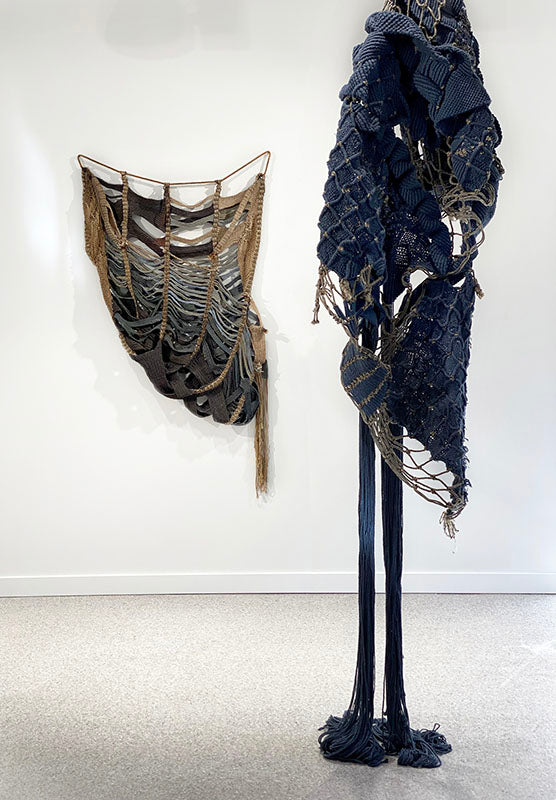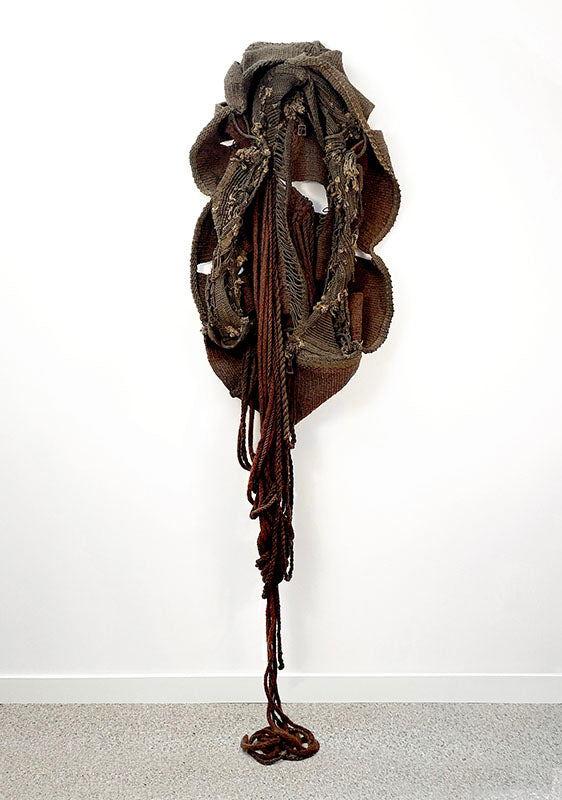Tell us about yourself, how did you become an artist?
My work is seeded in self-taught explorations with textiles as a teen in 1970s Midwest suburbia, with influence from the now-iconic artists of the burgeoning fiber movement. While studying what I perceived to be the more practical field of graphic communications I would insert “but I used to work with fiber” until gradually that was no longer a part of my consciousness. When I found myself at Shelia Hicks’ massive retrospective at the Pompidou some forty years later, I was overwhelmed with the certainty that I was supposed to be creating fiber art, marking the beginning of my current practice.
What is your background? and how did it inform the focus of your creative exploration or the medium you're currently working with?
After I spent a good part of my high school years weaving on loom and off, returning to the form was a matter of muscle memory – it literally felt like coming home. Coming home, it turns out, is complicated. Much of my work addresses my inclination to hang on to the past and the pitfalls of nostalgia. In part, I think that’s why I’m drawn to using vintage nets as armatures. Mending their worn imperfections into the new becomes metaphor for the difficulty of holding on, yet reluctance to let go.
What ideas interested you in the beginning of your practice, which ideas have you continued to explore, and where have they led you?
When I first began weaving on an aging net, I’d been caring for a father in declining health. In that, I felt an abstract correlation to the careful tending of a deteriorating object. I found the slow process of weaving within and across its fixed borders allowed me space to begin to process the layers of my own history. As I continue, reclaiming these once-functional nets through the personal and historically feminine gaze of compliance, erasure, renewal, motherhood and eldercare, I ponder my own changing use.

What began as autobiographic meditation has evolved into work that more broadly speaks to histories, loss and longing and exists in other realms of interpretive possibilities.
Who were and are the biggest sources of your inspiration?
I continue to find inspiration in the artists that initially drew me into the fiber arts, among them Magdalena Abakanowicz, Josep Grau-Garriga and Shelia Hicks. Al Loving, who was producing work at the same time, is a new inspiration for me. Influenced by a quilt exhibit at the Whitney, his torn and stitched canvases are a complete departure from the geometric canvases for which he’d been widely recognized. The ability to pivot so completely and intentionally is as inspiring as the art itself.
Where do you find inspiration?
I think of Françoise Grossen’s comment: “It is the actual making that brings me closer to what I am trying to say.” The nets themselves are my inspiration. They have a raw tactility that elicits a sort of empathy. Though I begin each piece with a specific impulse prompted by the familial moments and unexpected associations the nets’ past lives evoke, I allow them great freedom to determine their ultimate direction.
Is there are a single work, project, or series that is pivotal in your current trajectory?
My first piece, “Horse to Water,” is built on a horse fly net I’d acquired decades ago as an interesting object without knowing its prior function or imagining its future use. Since I lacked a traditional work set-up, its rope structure as make-shift warp became an invitation back into fiber arts and set me on my current path.
How did it begin? and how did it evolve?
What began as a serendipitous discovery has become integral to my work. Though I now weave on fishing nets and even hammocks, I’m especially connected to the fly nets. Horses are social creatures capable of fear, anxiety and loneliness. I’ve begun to explore more deeply how parallel human conditions can be mirrored by their worn nets.
Beyond personal connections to the life of these ropes, I’m increasingly interested in their function as objects. My work explores the tension between nets as protection, nets as entrapment and the often-blurred boundaries in between, questioning the meaning of objects and our own conceptions of security.
What were important lessons in the process that you’ve carried forward with you?
Don’t look back with regret. Though I often wonder what might have been had I pursued an art practice as a young adult, I recognize that all of my life experiences have gotten me to where I am and that, for me, has created stronger voice.

What are you working on now?
I’ve begun a series on leather fly nets that grapples with the construct of nostalgia. Remember that song so many of us sang in grade school, “Over the River and Through the Wood?” The promise it holds is a bit of an oversell. Holidays can be stressful, with winter dark and unbearably cold and grandmother, even in a good year, might be utterly alone.
If you could go back in time to the very beginning of your art practice and give your younger self a single piece of advice what would it be?
Find and cherish mentors.
About the Artist
Based in Mendota Heights, Minnesota
Minnesota artist Amy Usdin reclaims vintage fiber nets as armatures for sculptures that speak to memory, nostalgia and the meaning of objects. She exhibits locally and nationally with recognition including a 2020 Artist Initiative grant from the Minnesota State Arts Board and the 2019 Surface Design Award from the Surface Design Association’s International Exhibition in Print.
amyusdin.com




